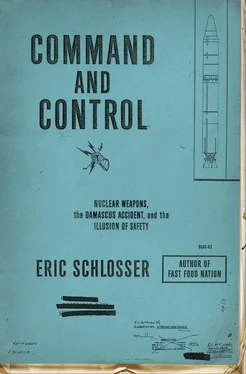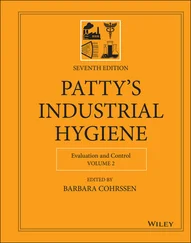Every Titan II launch complex had exactly the same layout: access portal, blast lock, then another blast lock, missile down the corridor to the right, control center down the corridor to the left, blast doors at the most vulnerable entry points. Every complex had the same equipment, the same wiring, lighting, and design. Nevertheless, each had its quirks. Blast door 9 at one site might require frequent maintenance; the control center air-conditioning might be temperamental at another. The typical crew was assigned to a single complex and pulled every alert there. Some crew members had spent two nights a week, for ten years or more, within the same underground facility. But an instructor crew served at different sites, depending on their availability. Al Childers had gotten to know all of the Titan II complexes in Arkansas and, for the most part, couldn’t tell the difference between them. Sometimes he had to look at the map on the wall of the control center to remember where he was. One launch complex, however, stood apart from the rest: 373-4 was known as the “ghost site.” It was the first complex where Childers was stationed, and odd things seemed to happen there. Pumps that could be operated only by hand suddenly went on by themselves. Lights turned on and off for no reason. Childers didn’t believe in the supernatural, and most officers laughed at the idea that the complex might be haunted. But some crew members thought that every now and then it felt pretty odd down there. Rodney Holder was once working in the silo at night with another crew member. The silo had a manually operated elevator that traveled from levels 2 to 8, and the men had left its door open. The bell in the elevator started to ring. It rang whenever the door was open and someone on another level needed the elevator. Holder couldn’t think of anyone who might need a ride. He called the control center and learned that nobody else was in the silo. The bell kept ringing. Holder and his partner were spooked, quickly finished their work, and returned to the control center.
• • •
LAUNCH COMPLEX 373-4 HAD BEEN the site of the worst Titan II accident thus far. On August 9, 1965, the complex outside Searcy, Arkansas, was being modified to make it more likely to survive a nuclear strike. Construction crews were hardening the silo, improving the blast doors, adjusting the hydraulics, installing emergency lights. The reentry vehicle and the warhead had been removed from the missile (serial number 62-0006). But its fuel tanks and oxidizer tanks were full. Four crew members manned the control center, as scores of construction workers labored underground and topside on a hot summer afternoon.
It was Gary Lay’s first day on the job. He was seventeen years old and had just graduated from high school in Searcy. His father had found him work at the complex. Lay was glad to have it. The money was good, and the temperature in the silo was a hell of a lot cooler than it was outdoors. Lay had been hired for the summer to do menial tasks and clean up after other workers. He’d never visited a missile complex before. His safety training consisted of watching You and the Titan II , a one-hour film. When it was over, Lay was handed a mask with a filter and told, in case of emergency, to use the elevator. He spent the morning at the bottom of the silo, quit for lunch around noon, and came back an hour later.
At approximately one o’clock, Lay was standing in the underground cableway when someone asked him to grab a bucket and a mop from the silo. He walked down the corridor, which entered the silo at level 2. A few minutes later, he was talking to a group of workers in the level 2 equipment area, not far from the emergency escape ladder. Men were busy in all nine levels of the silo, some of them painting, others flushing the hydraulic system that raised and lowered the steel platforms beside the missile. Lay heard a big puff, like the sound of a gas stove being lit, and felt a warm breeze. Then he saw bright yellow flames rising from the floor to the ceiling. He ran to the escape ladder and tried to climb down, but the ladder was jammed with workers. Moments later, the lights went out. Black smoke filled the silo, and it soon felt like the darkest place on earth. Workers were shouting, panicking, desperately trying to find a way out. Lay somehow managed to get back to the level 2 equipment area. He blindly felt his way along the wall, fell down, got back up, and instinctively headed toward the origin of the fire while others ran away from it.
At about the same time that Lay heard the big puff and felt the heat, the FIRE DIESEL AREA light in the control center began to flash red. Klaxons sounded throughout the complex, and the revolving red status light on the outdoor pole lit up. Captain David A. Yount, the crew commander, told everyone to evacuate, giving the order three times over the public address system. And then the power went out.
Pipe fitters who’d been working on the blast doors ran up the access portal stairway. Smoke pouring from a vent in the silo door told workers topside that something was wrong. A number of them tried to get down to the silo but were driven back by thick clouds of smoke. Lay made it to the cableway, then to the control center, suffering from second- and third-degree burns. He was placed in a decontamination shower. While Lay was being rinsed off with cold water, two crew members, Sergeant Ronald O. Wallace and Airman First Class Donald E. Hastings, put on air packs, grabbed fire extinguishers, and prepared to enter the silo. Amid the commotion, they noticed that another worker, Hubert A. Saunders, was calmly sitting in the control center. Saunders had been painting at level 1A of the silo, near the top of the missile, when smoke started drifting toward him. The lights went out just as he reached a ladder, and he climbed twenty feet down in the pitch black. Saunders had worked at Titan II complexes for years and knew the layout. He held his breath while passing through the level 2 equipment area, then crawled on his hands and knees down the cableway. Aside from inhaling some smoke, he was fine. And he’d never let go of his paint can and brush. Wallace and Hastings rushed down the long, dark cableway to battle the fire and rescue survivors. The smoke was so dense that they could not see the floor.
Saunders and Lay were escorted from the complex and taken by ambulance to the hospital in Searcy, where preparations were hastily being made to treat dozens of injured workers. Hours passed, but none arrived. The flash fire in the equipment area on level 2 had filled the silo with smoke, then sucked the oxygen out. The exit to the cableway from level 2 offered the only possibility of escape. Some workers had mistakenly climbed down the ladder toward the bottom of the silo. Others were blocked trying to climb up. One was trapped in the elevator when the power went out. Workers weren’t killed by the flames. They were asphyxiated by the smoke. Of the fifty-five men who’d returned to the silo after lunch, only Saunders and Lay left there alive.
Helicopters brought firemen from Little Rock Air Force Base to 373-4, but their work was hampered by the poor visibility. They managed to extinguish a few small fires on level 2, but fire was no longer the real danger. Without power, the site lacked air-conditioning, and as the temperature in the silo rose, so did the pressure in the missile’s oxidizer tanks. Nitrogen tetroxide expanded in the heat; its boiling point was only 70 degrees Fahrenheit. By five o’clock that evening, the temperature in the silo was 78 degrees and rising. Opening the silo door would help cool the missile and vent the smoke — but the door couldn’t be opened without electrical power. Smoke had seeped into the control center as well, complicating efforts to manage the crisis. All four blast doors had been propped open so workers could freely move within the complex. The pins on blast door 8, at the entrance to the control center, had deliberately been left extended so the door wouldn’t shut. And without power, the pins couldn’t be retracted. At seven o’clock, SAC headquarters in Omaha warned that if the temperature in the silo wasn’t reduced, the missile’s stage 2 oxidizer tank was likely to reach an “explosive situation” around midnight.
Читать дальше












